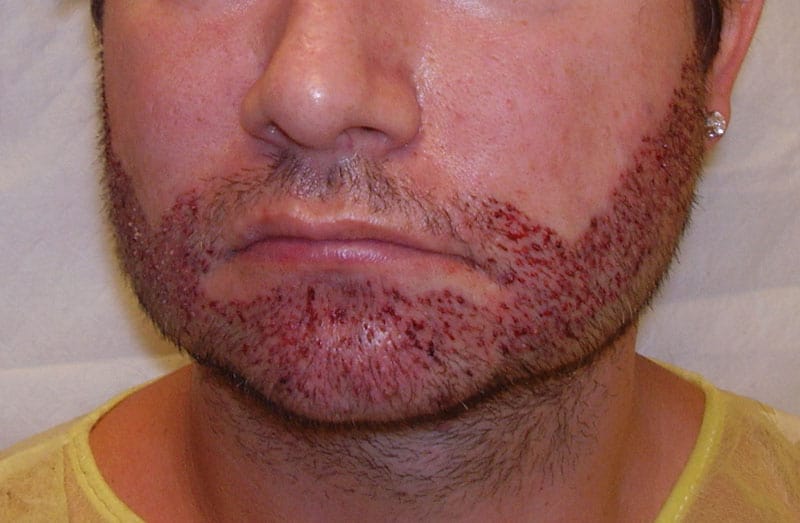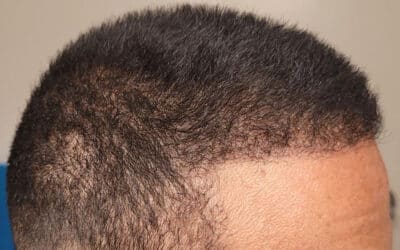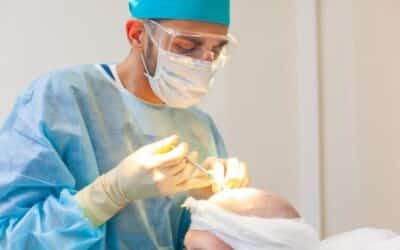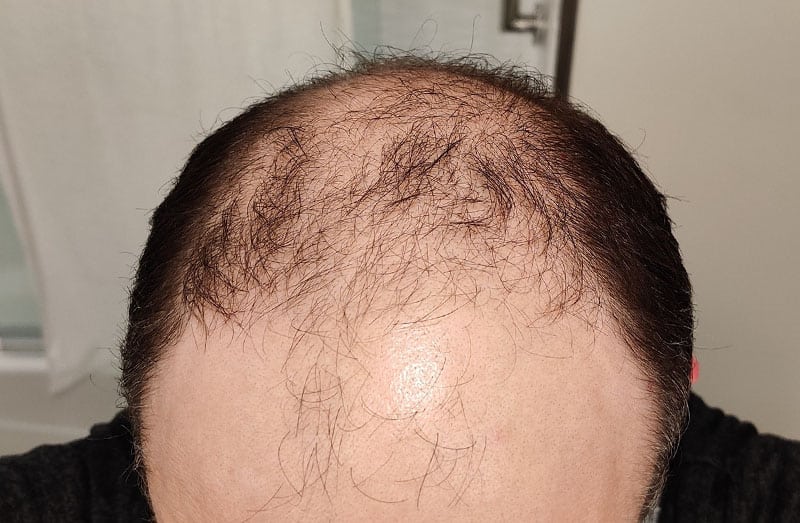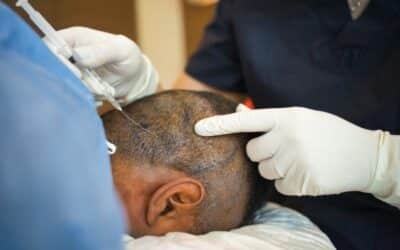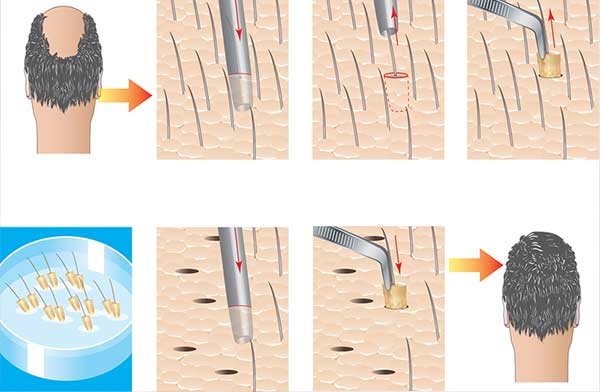An FUE, also known as a Follicular Unit Extraction, is a popular hair transplant procedure in which individual hair follicles are extracted from one area of the scalp (the donor area) and transplanted back into the bald or thinning area (recipient area). The FUE procedure is considered to be a minimally invasive operation. As a result, patients aren’t left with a linear scar in the same way the Follicular Unit Transplant FUT procedure does.
Oh, you already knew that? You’re fully aware you need a hair transplant doctor? You want to know when will FUE hair grow after your Follicular Unit Extraction Transplant? Hum… makes sense. You arrived at this blog post after all.
OK, so you’re interested in an FUE transplant and you’re wondering when will FUE hair grow after a hair transplant, right? Well, there is no simple blanket or generic answer to give you. After all, each patient is different, has a different body, a different hairloss history, and will react differently. However, there are commonly accepted phases of the hair transplant process that may help answer when will FUE hair grow for the average patient.
There are a number of things to keep in mind about FUE hair transplant procedures and we recommend reviewing those before reading on. However, if you’re only interested in the FUE hair growth aspects and expectations based on the day-to-day, week-to-week, and month-to-month progression, you’ll find all the info you need below.
The Basics of Hair Transition Phases of Hair Restoration Surgery
For the most part, the simple answer to when will FUE hair grow can be best expressed using the following growth phases which take place during the first 12 months and upwards of 18 months. These hair restoration phases include the Initial Shedding phase, the Transition phase, the Visible Growth phase, and the Maturity phase.
However, patients notice the changes in appearance immediately, especially considering they did just get surgery on their head. You see the freshly-implanted grafts. It may look a bit odd. Additionally, you’ll see scalp irritation. Finally, you’ll see scabbing. Those simple observations aside, typical expectations of each phase are referenced below.
Typical Expectations of the Hair Restoration Phases
- The Initial Shedding Phase: Within the first two weeks after the transplant, some of the transplanted hair may fall out. This normal yet surprising part of the hair growth cycle is no cause for concern. We understand why it may be weird for the new hairs to fall out but it’s just the way it goes.
- The Resting to Active Transition Phase: Over the next few months, the hair begins to transition from a “resting phase” to what we call the “active growth” phase. This is when the transplanted hair follicles begin to produce new, permanent hairs. This is where the fun begins and when you begin to see the new you take shape!
- The Visible Growth Phase: Around 3-6 months after the transplant, the new hair will start to become visible. The growth rate will vary from person to person, but on average, hair will grow about a quarter of an inch per month. Between the 6th & 12th months, your hair will look more full and more natural and you’ll be able to begin shaping and styling it in a variety of unique ways.
- The Hair Maturity Phase: About 12-18 months after your hair restoration transplant, your transplanted hair should appear fully mature and look like your real hair would have if you had never lost it in the first place. At this point, the hair should have reached its full length and thickness. Of course, you can continue to grow your hair out as long as you want, however by this point, the full results should be concrete and the hard part of your journey has concluded. Now it’s all about maintenance and care… and enjoying your amazing new head of hair!
Breaking Down the Hair Growth Phases After Your FUE Transplant

Will FUE Hair Grow During the “Initial Shedding” Phase?
After a hair transplant, it’s common for the transplanted hair to go through a stage of initial shedding. This typically occurs within the first two weeks after the procedure and is a normal part of the hair growth cycle.
During this stage, the transplanted hair will begin to shed from the scalp. This may seem alarming at first, but it’s important to remember that this is a normal process and not a sign of the transplanted hair failing. The shedding is simply the result of the hair transitioning from a resting phase to an active growth phase.
Patients can expect to experience some degree of shedding, as this is completely normal. It’s nothing to worry about and the extent of shedding can vary from person to person. Some patients may notice a significant amount of hair loss, while others may only notice a minimal amount. There’s nothing to freak out about but if you notice something very strange, by all means, contact your physician to get your questions answer. If all is well, you can expect the following from the Initial Shedding stage.
The Day-by-Day Expectations During the Initial Shedding Phase
Following the first couple of days after your FUE hair transplant procedure, the head and new grafts may appear thicker and fuller due to the swelling in the scalp. This is to be expected. After all, you did just have surgery, albeit not a highly invasive one. Don’t forget that you may have had thousands of holes poked in your head. Your body is going to react accordingly. Additionally, please remember that it’s completely normal for some hair to shed in the first few days, and the extent of this inevitable shedding varies from person to person.
In the next 3-7 days, transplanted hair grafts may continue to shed. Patients may notice a slight decrease in the overall density of the transplanted hair. However, as we said before, this is a normal part of the process and not a sign of the hair failing. During the remainder of the first week, you will also notice the scabs that formed on your scalp begin to heal and possibly start to fall off as well. Just don’t pick at them and let them fall out naturally. The less you irritate your scalp, the better. You certainly don’t want to mess with the process of restoring your hair.
Over the next week during days 8-14, the majority of the shedding should have subsided, scabs will have healed up, and the transplanted hair grafts should look relatively normal (all things considered). It’s critical patients understand the first stage of shedding and what to anticipate during this phase. While the shedding may be upsetting, it is a natural part of the hair restoration process.
The Importance of Following Instructions During the Initial Shedding Phase
Naturally, in order to achieve the best results, patients like yourself should constantly adhere to the aftercare recommendations made by a specialized hair transplant surgeon like Doctor Greg Powell. This may entail taking medicine, steering clear of certain activities, avoiding specific headgear, helmets, and head coverings, and lastly, practicing proper cleanliness.
Oh and as we said before, please don’t pick at your head. Ya, it can be tempting but just remind yourself not to in whatever way is necessary. With proper care, the transplanted hair will continue to grow stronger and healthier and you’ll successfully move on to the Transition phase of hair growth.
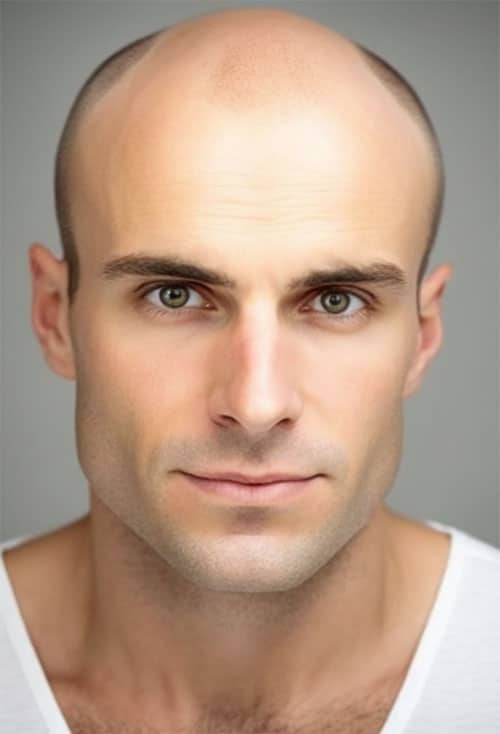
When Will FUE Hair Grow During the “Transition” Phase of Hair Transplant?
After the initial shedding stage, transplanted grafts enter the transition phase of new hair growth. During this time, the hair follicles will begin to produce new hair. The length of this stage can vary, but it typically lasts between 2-3 months.
Week-by-Week Expectations During the Transition Stage
As we noted in the previous section, during the first 2 weeks your scalp will be in healing mode. This is also the time you’ll see some hair shedding. However, by week 3 and into the remainder of the first month or so, your new hairs should have stabilized. As a result, new hair growth should become more visible. During this phase, hair transplant patients like yourself may also notice a slight increase in the overall density of the transplanted hair. However you have a long way to go and any visible grow will likely look very fine, thin, or whispy.
Ok, so you’ve made it past the first month! Good for you! Now during weeks 5 and 6, you’ll likely see new hair growth that should start to become more noticeable. Additionally, you may notice an increase in the overall density of the transplanted hair. Furthermore, your new hair growth may start to take on a more natural appearance as it continues to recover and mature.
By the time you finish off weeks 7 through 8 and hit the 2-month timeframe, new hair growth becomes quite prominent and looks even more natural as time goes on. Our patients typically notice a slight increase in the length of the new hair which makes sense as you haven’t had a cut for a while now. However, this hair will still be thinner and less dense than it will be in the following months.
Overall, the transition stage is an exciting time for patients as they start to see new hair growth. However, it’s important for patients to be patient and not expect too much too soon. The new hair will fill in gradually, and the final result will not be visible for several months.

The “Visible Growth” Phase of Hair Growth After a Transplant:
After the transition stage, the transplanted hair will enter what is known as the Visible Growth phase. In our opinion, this is the most exciting time for our patients because you truly begin to experience the benefits of getting a hair transplant procedure. As you’d expect, during this time, the new hair growth becomes more noticeable. Furthermore, transplanted hair follicles take on a more natural appearance. The length of the Visible Growth stage of hair restoration can vary from person to person. However, it typically lasts between 4-6 months.
Expectations During the Visible Growth Phase
During this first portion of the Visible Growth Phase, patients should start to see a noticeable increase in the overall density of the transplanted hair. Your thin whispy hair is now much thicker and it’s starting to look awesome! Your new hair growth should be more prominent, and the transplanted hair begins to take on a more natural appearance. At this point in time, it’s very likely that only your close family, friends, and co-workers may know that you were once balding.
Over the coming months, you’ll continue to see a noticeable increase in the length of the new hair. The overall density of the transplanted hair should continue to increase and more new hairs become even more visible than before. As long as your doctor has cleared you to do so, there’s a very good chance you may actually be able to start styling your hair during this phase. However, please consult your doctor before you begin doing anything like this. They make the final call about whether you are in a safe position to do so. Should they clear you, feel free to begin using products and brushing your hair the way you used to. Have fun with it and experiment. This is the beginning of the new you!
Overall, the visible growth stage is an exciting time for patients as they start to see the results of their hair transplant. However, it’s important for patients to be patient and not expect too much too soon. The final result will not be visible for quite a while longer, as this phase can last for 3-4 months. But don’t get too antsy. This is all part of the amazing journey you’re on and the best is yet to come!

The “Maturity” Phase of Hair Growth After a Transplant:
Well you’ve finally done it! You’ve made it to the Maturity phase! After the visible growth phase, your hair has spent a while maturing and establishing itself. During this time, the new hair growth reaches the points that dictate what its final appearance may look like. In the same way a young adult may look different 20 years from now, many features established in the earlier year carry on into the future.
As such, the hairs have not grown in where they will and taken root (I can’t help but make puns when they come along). Your hair is now able to really be played with. Brush it. Run your fingers through it. Let someone you like run your fingers through it! The point is you’re finally where you’ve been yearning to be for years. The length of this stage can vary, but it typically lasts between 6-12 months. However, this can reach into the 18-month period for some patients. Again, it’s about on a person-to-person basis.
Month-by-Month Expectations During the Maturity Stage
During the 4-6 months mark (the start of the Maturity phase), your hair should have reached its final length and appearance. The new hair growth should look natural and blend in with the existing hair you had before your transplant. Additionally, the overall density of your transplanted hair should be quite noticeable. As I said before, this is where you really reap the benefits hair restoration surgery offers to patients. These include both physical and emotional benefits which many hair loss sufferers experience before the surgery.
During months 7 through 9, transplanted hair should be fully established and should have reached its final appearance. Now when we say this, it’s not to say you can’t or won’t keep growing your hair out. This is simply to say that your hair has reached a point in which the results of your hair transplant are becoming extremely apparent. Finally, to complete the next 10-12 months and round out your year, your hair has fully matured and established itself. But there’s more!
For the next 6 months (or some time in between), you may still continue the maturity phase. It’s quite likely that during this time, you may choose to grow your hair out more or you may choose to cut and style your hair for the first time since your procedure. I have to tell you that getting your first haircut can be a bit scary but it’s also an amazing experience and one only hair restoration patients like yourself will be able to fully appreciate.
The End of Your Journey is Just the Beginning!
Overall, the maturity stage is the final stage of the hair transplant process. Technically it marks the end of the hair restoration journey for our patients. After this stage, the transplanted hair will continue to grow and provide the patient with a fuller, more youthful appearance. However, that’s not necessarily the end of your hair restoration journey. It’s a lifelong endeavor, much, in the same way, dental care is not a “one & done” kind of thing.
Hair transplants like FUE and FUT both require consistent maintenance to achieve the best long-term results. It’s important for patients to continue to follow aftercare instructions provided by your hair transplant surgeon. This ensures the best possible outcome. Both in the short-term and the long-term. Also, sometimes one procedure isn’t enough for certain patients.
You may need to have multiple FUE procedures. You may need to combine both FUE and FUT procedures. Furthermore, you may benefit from additional supplemental options including LLLT laser therapy, Minoxidil, Finasteride, or other hair vitamin supplements. However, with proper care, the transplanted hair will provide the patient with a long-lasting, natural-looking solution to hair loss.
YOUR HAIR RESTORATION SOLUTION
Best Hair Transplant
1970 S. Prospect Ave., Suite 2
Redondo Beach, CA 90277
(213) 403-0455
https://www.google.com/maps?cid=9280610872186794918



